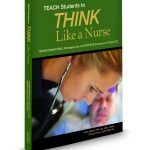
To safely administer medications, educators teach the essential “rights” (right patient, right, time, right dose, etc.) that students must memorize, recite, then integrate into their practice when it’s time to pass medications.
These rights are non-negotiable and are the foundation of safe medication administration and taught from the very beginning of the program and remain relevant and practiced all the wat through the final semester.
But in addition to the 5+ “rights” related to safe med administration, can you readily identify and list the 5 “rights” of clinical reasoning?
Levett-Jones, et. al. published the ground-breaking article, The ‘five rights’ of clinical reasoning: An educational model to enhance nursing students’ ability to identify and manage clinically ‘at risk’ patients in 2010.
This model and simplified approach to early identification and recognition of those patients most likely to experience a complication can mitigate and address the current problem of failure to rescue that continues to result in the needless loss of patient lives here in the United States and abroad.
These “rights” must be known then taught so students will be safe in practice by being vigilant and recognize the need to rescue and intervene when a patient develops a complication.
Be honest.
Did you even know that there are 5 “rights” related to clinical reasoning (1)? If you were not even aware that these “rights” existed in the literature, integrate these five rights into your curriculum and clinical paperwork so students are better prepared for practice.
But before I identify the five rights that Levett-Jones outlined, let’s lay a foundation that includes a DEEP understanding of what clinical reasoning entails.
As a nurse educator who remains current in practice, from my perspective the best definition of clinical reasoning is found in the writings of Dr. Patricia Benner.
This is the essence of what clinical reasoning requires so students are able to think more like a nurse:
Clinical Reasoning Defined:
The ability of the nurse to THINK IN ACTION and REASON as a situation CHANGES over time by capturing and understanding the significance of clinical trajectories and grasping the essence of the current clinical situation (2).
The ability of the nurse to focus and filter clinical data in order to recognize what is most and least important (what data is RELEVANT) so a problem can be identified if present (3).
Patient’s do not stay static, they either improve or can begin to swirl in the wrong direction and require the nurse to recognize the need to “rescue” before it is too late. Clinical reasoning is the use of essential knowledge when APPLIED to the bedside.
To improve practice readiness of your students, here are the five rights of clinical reasoning they need to know to be safe in practice after they leave your program and pass the NCLEX.
“Five Rights” of Clinical Reasoning
RIGHT Cues
Cues are the clinical data collected and clustered by the nurse. Recognizing the RELEVANCE and RELATIONSHIP of clinical data and contextualizing to your patient is the essence of this “right.”
When EARLY cues are missed or not identified such as a trend of an elevated heart rate and softening BP, allowing a complication to progress is a classic example of “failure to rescue” by the nurse.
RIGHT Patient
This “right” is not about checking the name and date of birth of your patient, but the importance of the nurse to identify if your patient is high risk for developing a potential complication.
The nurse must be able to recognize that an 18-year-old with an appendectomy is not as likely to develop a complication as a patient with the same problem who is 78!
RIGHT Time
This refers to the timeliness of identifying a high risk patient among multiple patients you may be caring for.
Recognizing EARLY signs of a complication and then initiating nursing interventions at the RIGHT time and in the RIGHT sequence is imperative.
Remember that “failure to rescue” is not only a failure to recognize a complication that develops but also when nursing/medical interventions are started too late.
RIGHT Action
Once a clinical judgment is made, the right action or intervention must be undertaken by the nurse. Did you know that on a typical med/surg floor over an 8-hour shift a typical nurse engages in 50 significant clinical reasoning concerns that require a clinical judgment?
Clinical data that suggests a potential complication must be acted upon.
The consequences of an incorrect clinical judgment can make the difference between life and death. In one study, one half of patients who had cardiac arrests on the floor of a hospital had clinical signs of deterioration 24 hours before the arrest but were NOT acted upon by the nurse.
RIGHT Reason
The right reason is not just making the correct reasoning that leads to a nursing judgment, but understanding the rationale or WHY of everything that is done in practice by the nurse.
To do this consistently the nurse must be able to apply clinical reasoning to the bedside which include grasping the essence of the current situation and put the clinical puzzle together to see the big picture (1).
Make it Stick!
As a newer nurse educator I quickly realized that my students struggled with this concept of identification and recognition of potential complications. This is an applied skill that requires clinical experience to strengthen.
But by asking the right questions you can develop essential clinical reasoning rescue muscles in your students. Here are four sequential questions I have successfully used with my students that you too can utilize and integrate in your clinical education:
- What is the worst possible/most likely complication(s) to anticipate based on the primary problem?
- What nursing interventions could prevent this complication? (if applicable)
- What specific nursing assessments will identify this problem early?
- What nursing interventions need to be implemented if this complication develops?
These questions are intuitive to an experienced nurse. As I reflected on my current nursing practice, I made these questions intentional to my students.
If you look carefully you will see the essence of nursing process and a care plan that emphasizes the need for possible rescue with the priority problem that can develop identified, nursing assessments and interventions to implement if needed.
Practice the Five Rights!
Any nursing skill such as med administration or sterile technique needs to be practiced repeatedly to develop proficiency and competence.
Being able to clinically reason by identifying and recognizing the need to rescue is the most skill your students must possess to be safe in practice; it also needs to be repeatedly practiced.
Action Steps
As I travel around the country and share practical and practice-based strategies to strengthen clinical decision-making, most educators have never heard of this article and its foundational premise of teaching five “rights” to rescue.
That needs to change.
If you need to learn more about the five rights and improve problem recognition in your curriculum then take the following action steps:
- Download and read the groundbreaking article that remains relevant 10 years later by Tracy Levett- Jones and her nurse educator colleagues from the land down under in Australia!
- Integrate the five rights and/or the clinical reasoning questions I have developed based on these rights in your clinical paperwork.
- Teach these rights to your students and pass on your downloaded article to your educator colleagues and discuss in your next staff meeting!
- Download one of my case studies and see for yourself how you can easily practice this essential nurse thinking skill.
In Closing
Nurse educators have a moral and ethical responsibility to do all that is needed to prepare students for real-world clinical practice.
Because every patient has the potential to develop a complication that can be life-threatening, emphasizing clinical reasoning and its application to problem recognition and the need to rescue must be a part of your curriculum.
If this emphasis is lacking, do what is needed to integrate then implement these rights and rescue questions in your clinical curriculum and paperwork or practice using case studies in your classroom.
By taking this small step you can ensure that your students graduate practice ready by identifying and recognizing the most common complications experienced in clinical practice and may even save a life!
Related Blogs
- I See Dead Patients
- Why Clinical Reasoning is Foundational to Nursing Practice
- How to Effectively Teach Clinical Reasoning
Guide to Facilitate Change for Educators
I wrote TEACH Students to THINK Like a Nurse to be a written guide to successfully implement educational best-practice to develop the thinking required for practice and the current and upcoming NextGen NCLEX®.
References
1. Levett-Jones, T., Hoffman, K., Dempsey, J., Yeun-Sim Jeong, S., Noble, D., Norton, C…Hickey, N. (2010). The ‘five rights’ of clinical reasoning: An educational model to enhance nursing students’ ability to identify and manage clinically ‘at risk’ patients, Nurse Education Today, 30, 515-520.
2. Benner, P., Sutphen, M., Leonard, V., & Day, L. (2010). Educating Nurses: A Call for Radical Transformation. San Francisco, CA: Jossey-Bass
3. Benner, P., Hooper-Kyriakidis, P. & Stannard, D. (2011). Clinical wisdom and interventions in Acute and Critical Care: A thinking-in-action approach.(2nd). New York, NY: Springer.
Keith Rischer – PhD, RN, CEN
As a nurse with over 35 years of experience who remained in practice as an educator, I’ve witnessed the gap between how nursing is taught and how it is practiced, and I decided to do something about it! Read more…
The Ultimate Solution to Develop Clinical Judgment Skills
KeithRN’s Think Like a Nurse Membership
Access exclusive active learning resources for faculty and students, including KeithRN Case Studies, making it your go-to resource.




